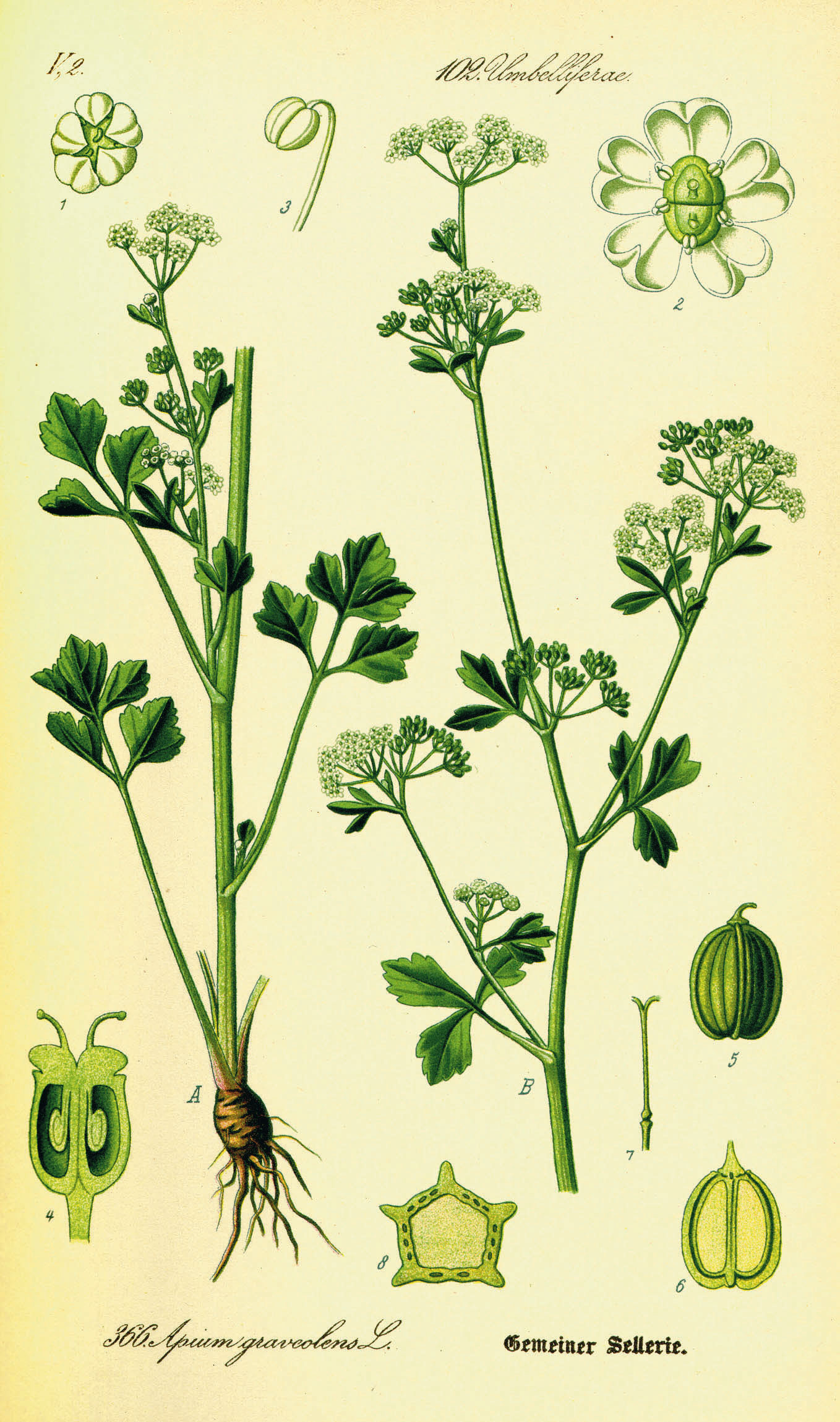Nutrition for Celery
Calories, Protein, Vitamins and More
Celery Nutrition Summary
One stalk of celery (64 grams or 2.26 oz) contains 9 calories and 0.4 grams of protein. Celery consist of 95% water, 3% carbohydrates, and less than 1% of protein or fat.Celery is an excellent source of a few nutrients, including calcium and potassium.
In one stalk of celery:
- Calories: 9
- Protein: 0.4 g
- Sugar: 0.9 g
- Dietary fiber: 1 g
- Fat: 0.1 g
- Sodium: 51.2 mg
See the Celery Nutrition Chart for complete recommended daily values.
The specific nutritional values from USDA is for: Celery, raw.
Calories in Celery
Celery has 9 calories per stalk or 14 calories for every 100 grams. Most of its calories are from carbohydrates and protein.75% of calories in celery are from carbohydrates, 16% of calories are from protein and 9% of calories are from fat.
Calories from Carbs
The majority, or 75% of the calories in celery are from carbohydrates.
The carbs in celery are mostly in the form of dietary fiber and sugar (53% and 47%). 1 stalk of celery has 4% of daily values or 1 grams of dietary fiber.
- Dietary fiber: 1 g
- Sugar: 0.9 g
Calories from Fat
A small portion, or 9% the calories in Celery are from fat. Celery is very low in total fat, with 0.1 grams per stalk. Most of the fat in celery are healthier unsaturated fats.
Celery is cholesterol free and trans-fat free.
Celery is cholesterol free and trans-fat free.
- Total fat: 0.1 g
- Polyunsaturated fat: 0.1 g
Omega-6 in Celery
Celery contains a small amount of omega-6 fatty acids, mostly in the form of linolenic acid - the only essential omega-6 fatty acid.
[2]
- linoleic acid: 0.05 g
Calories Similar to Celery
Some other vegetables with similar calories to celery by weight:- Iceberg Lettuce: same
- Bok Choy: -1 calories
- Cucumber: +1 calories
- Kimchi: +1 calories
Protein in Celery
A single stalk of Celery contains 0.4 grams of protein. Celery is relatively low in protein, and is not a source of complete protein, containing little or small amounts of the majority of the nine essential amino acids.- Protein: 0.44 g
- Leucine: 0.02 g
- Lysine: 0.02 g
- Valine: 0.02 g
Protein Similar to Celery
Some other vegetables with similar amounts of protein to celery by weight:- Radishes: same
- Jicama: same
- Cucumber: same
- Baby Carrots: same
Vitamins and Minerals in Celery
An good source of nutrients, celery contains abundant amounts of calcium and potassium. In fact, a single stalk of celery contains 7% of recommended daily values or 166.4 milligrams of potassium. Also an excellent source of calcium, a single stalk of celery contains 3% of recommended daily values or 25.6 milligrams of calcium.Vitamins in celery (1 stalk):
- Vitamin a: 14.1 ug
- Riboflavin: < 0.1 mg
- Niacin: 0.2 mg
- Vitamin b6: < 0.1 mg
- Vitamin c: 2 mg
- Vitamin e: 0.2 mg
- Folate: 23 ug
- Vitamin k: 18.8 ug
- Calcium: 25.6 mg
- Potassium: 166.4 mg
- Iron: 0.1 mg
- Magnesium: 7 mg
- Zinc: 0.1 mg
- Selenium: 0.3 ug
- Phosphorus: 15.4 mg
- Manganese: 0.1 mg
- Choline: 3.9 mg
Similar to Celery for Potassium
Here are some other vegetables with similarly abundant amounts of potassium to celery:- Zucchini: +0.64 MG
- Bok Choy: -5.1 MG
- Jalapeno: -7.7 MG
- Romaine Lettuce: -8.3 MG
Flavonoids and Carotenoids in Celery [3]
Celery contains a number of healthy phytonutrients and antioxidants, specifically carotenoids beta-carotene and lutein + zeaxanthin and flavonoids apigenin, luteolin, kaempferol and quercetin. In one stalk of celery:
- beta-carotene: 173 ug
- lutein + zeaxanthin: 181 ug
- apigenin: 1.82 mg
- luteolin: 0.67 mg
- kaempferol: 0.14 mg
- Quercetin: 0.25 mg
Celery Nutrition Chart
|
Celery:
( -
g )
|
||
|---|---|---|
| calories |
|
KCAL % |
| carbohydrates |
|
G % |
| dietary fiber |
|
G % |
| sugar | G | |
| total fat |
|
G % |
| saturated fat |
|
G % |
| monounsaturated fat | G | |
| polyunsaturated fat | G | |
| protein |
|
G % |
| sodium |
|
MG % |
| Vitamin A |
|
UG % |
| Vitamin C |
|
MG % |
| calcium |
|
MG % |
| iron |
|
MG % |
| magnesium |
|
MG % |
| potassium |
|
MG % |
| thiamin (Vitamin B1) |
|
MG % |
| riboflavin (Vitamin B2) |
|
MG % |
| niacin (Vitamin B3) |
|
MG % |
| Vitamin B6 |
|
MG % |
| pantothenic acid (Vitamin B5) |
|
MG % |
| folate (Vitamin B9) |
|
UG % |
| Vitamin K |
|
UG % |
| Vitamin E |
|
MG % |
| histidine |
|
G % |
| isoleucine |
|
G % |
| leucine |
|
G % |
| lysine |
|
G % |
| methionine |
|
G % |
| phenylalanine |
|
G % |
| threonine |
|
G % |
| tryptophan |
|
G % |
| valine |
|
G % |
| Water | G | |
| selenium |
|
UG % |
| zinc |
|
MG % |
| choline |
|
MG % |
| copper |
|
MG % |
| phosphorus |
|
MG % |
| fluoride |
|
UG % |
| manganese |
|
MG % |

